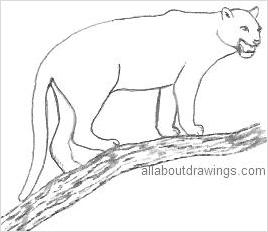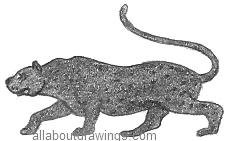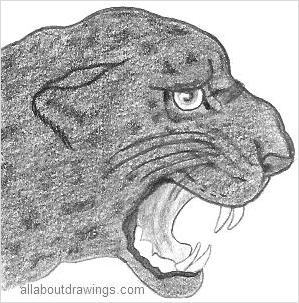Search for images or info
Panther Drawings
I created these panther drawings with a mechanical 2B pencil on photocopy paper.
When I started to draw, I spent a lot of time browsing through books to find easy outlines for me to copy. As it turns out, this was a really great way to practice for 2 main reasons:
- Easy subjects = good results = encouragement to continue.
- Your skills are improving while you are enjoying yourself.

Try copying this simple outline of a panther and convert it into an illustration with your own creative touch. As the designing artist, you have many options at your disposal. For example,
- the tree branch can be changed into a protruding rock,
- create an interesting background,
- add color
Any or all of these alterations will result in original artwork by you.
There are many various methods of shading that you can implement, it's just a matter of what you feel like experimenting with when you select your next topic and whether it will suit that particular piece.
With the panther drawings on display here, I felt that plain shading was required, however, they aren't so dark that you can't see the appropriate details that define a panther.
About The Black Panther

The black panther is really a dark leopard.
If you dared get close enough, you would see that it really does have darker spots -- I'm happy to just take the expert's word on that one!
The lion and the tiger are bigger than a leopard.
The leopard is an expert tree climber.
The type of leopard that lives in a forest is a darker leopard than the ones that live on open plains. You are more likely to find a panther in a forest.
The puma is referred to as a cougar, a mountain lion and sometimes it is called a panther. To me, the lines seem blurred as to what a panther really is.

When an artist gains a bit of experience, they use their knowledge of the cat family to draw any type of cat. That's because the basic profile is similar for all cats like the leopard, puma, cheetah and tiger.
Knowing this fact will help you to draw the animal more accurately. All you have to do is add a bit of character that pertains to your particular subject.
You lessen your chances of making errors in ignorance if you understand the principals of the cat.
Categories
Sketches
Instruction
Freebies
Other Areas
** Disclaimer: I receive a small commission if you buy via my links -- at no extra cost to you. **
The How To Sketch Guide
Here's a book that finally dispels the mystery of sketching!
... it only takes a little instruction
or guidance... Read more >>
Use Emotion
I realized when I was doing these panther drawings, that I wasn't putting any emotion into them. I was concentrating so hard on getting the outline right that I didn't think to inject my own personality into it. I have to release that rigid discipline and put in more emotion. I am assuming that will evolve with practice and time.
When you draw, ask yourself some questions like these ...
- What am I feeling about the black panther?
- Can I feel his strength emanating from the drawing?
- Have I portrayed that strength well enough?

You may find drawing difficult sometimes, I know I do, but that's nothing compared to the pleasure to be had. Like when you finally get an illustration right, the satisfaction is very rewarding.
The art of drawing opens your eyes to the world and you start to see things you have never noticed before.
Just keep persevering and you will ultimately succeed at drawing. The greatest secret in learning to draw is to practice as much as you can. You'll derive many benefits if you get into the habit of carrying around a sketchbook and draw every little thing you see.
Good luck with your panther drawings. I admit I had quite a few practice sessions before I was satisfied with the ones I am showing you today. As for degree of difficulty, hmmm, animals and humans are subjects that I need to focus on a lot more before I see real improvement. Going by what I read and feedback, it seems they are the typical harder topics to master.
If you keep an open mind and show no fear, you can draw whatever you want to. The older I get, the more convinced I am that our minds are very powerful. I wish you all the best in your artistic adventures.
Click a link below to view various animal illustrations:
* Allaboutdrawings.com is a participant in the Amazon Services LLC Associates Program, an affiliate advertising program designed to provide a means for sites to earn advertising fees by advertising and linking to Amazon.com.
Copyright © 2005 - 2025 www.allaboutdrawings.com. All rights reserved.






